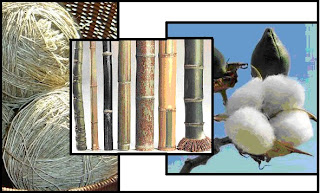Conscious Fashion: Alternative Textiles

This week’s column was inspired by a fan of Carbon who asked me about bamboo clothing. As I said last week, I am no fashion expert and I had no idea bamboo clothing even existed! I now had a mission: alternative textiles. My search led me to some really bizarre things (Ever searched the word ‘hemp’ before? Yeah…) but it also led me to lots of new products, companies, and ideas.
I have come to the conclusion that there are basically three main categories of alternative textiles out there (at least for clothes): hemp, organic cotton and bamboo. There seems to be some debate as to which is actually the most eco-friendly and all of them have drawbacks.
Hemp is produced from a plant in the genus Cannabis which, as you might have guessed, is the same family from which marijuana comes. However, the plant that is used in hemp has insignificant amounts of the chemical that induces the drug experience, tetrahydrocannabinol (THC). It’s a completely different plant- as different as you are from your crazy cousin. The reason it’s more eco-friendly than other textiles is because it is resistant to drought and its yields are not as susceptible to pests. Also, it is stiff competition for weeds since it’s such a tough plant, so farmers don’t have to use herbicides on Cannabis crops.
Everything that I have heard and found about hemp cites the same drawback; it’s simply not a soft, wearable fabric. So as far as clothing goes, it’s pretty much out- except for the occasional hemp/cotton blend hoodie. But it definitely has other uses! (Check out these awesome hemp produce bags!)
Organic cotton is also a popular alternative textile. What makes it organic is pretty simple. It is cotton grown under strict pesticide-use rules and without synthetic fertilizers. Farmers of organic cotton have to answer to the USDA. Almost 11,000 acres of this puffy white stuff was planted in the US in 2009. But American growers have some serious competition from organic cotton industries in other countries, since globally it is an industry worth $4.3 billion.
Unlike hemp, organic cotton is very wearable and extremely comfortable, just like its non-organic counterpart. (Think your favorite cotton V-neck, only softer). Sites like ecomum advertise baby clothes and baby washcloths made from organic cotton and Alternative Apparel sells dozens of shirts made with it.
Finally, bamboo– this might be the winner as far as softness goes. But there’s debate as to whether or not it’s the most eco-friendly. The re-growth cycle of bamboo is fast compared to other trees and plants used for textiles. Though it doesn’t require irrigation like cotton, it grows in a very different climate than what is available in the US, which means it is largely imported, which definitely defrays its other positive impacts. (But if you’re in China or you live near a bamboo farm and you’re reading this article, then bamboo is an excellent choice!)
But like I said, it is a great material for clothes and linens. I love these scarves from Green Earth Bamboo and this dress from Five Bamboo– and from the same company, these Bamboxers (bamboo boxers)! Another online bamboo retailer with cute clothing is DoBamboo.
The main lesson I want you to take away from this is that researching your products is crucial. Know what it’s made of, where the seller gets their materials and what it could be blended with. There are more blended textiles out there than most people are aware of. Just because you’re buying a bamboo shirt, doesn’t mean it is 100% bamboo. What it’s blended with matters.
There you have it: Alternative Textiles 101! Happy shopping!
Is there a conscious fashion topic you want to see featured? Submit to carbontheblog@gmail.com!
Is there a conscious fashion topic you want to see featured? Submit to carbontheblog@gmail.com!
1 thought on “Conscious Fashion: Alternative Textiles”
You must be logged in to post a comment.

Very interesting! Who knew that bamboo was a wear-able?!?